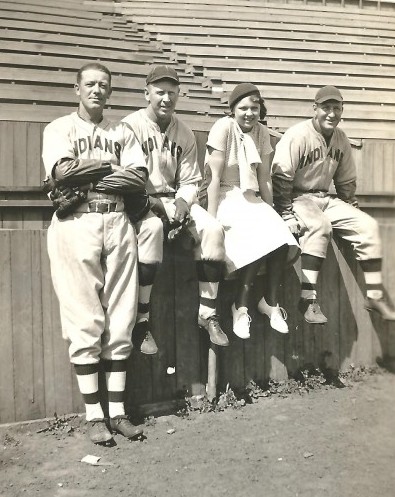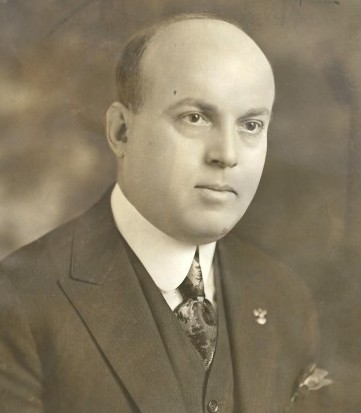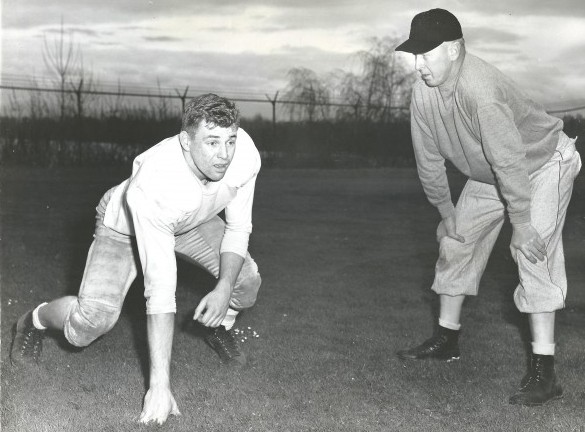
By David Eskenazi and Steve Rudman
Seven members of the Pro Football Hall of Fame also played major league baseball (in alphabetical order): Morris “Red” Badgro, John “Paddy” Driscoll, George Halas, Ernie Nevers, Clarence “Ace” Parker, Deion Sanders and Jim Thorpe. Badgro is hardly the most famous man in the septet, but for many years was considered the greatest all-around athlete produced in the Pacific Northwest, and is still the answer to several trivia questions.
Who scored the first touchdown in the NFL’s first championship game?
Who is the only man to play for the football versions of the New York Yankees (1927-28), New York Giants (1925-present) and Brooklyn Dodgers (1930-43)?
Who is the only man to block for Red Grange and coach Hugh McElhenny?

Who is the oldest man elected to the Pro Football Hall of Fame?
Born Dec. 1, 1902 in Orillia, WA., a long-gone community southwest of Renton in the Green River Valley, Morris Hiram Badgro starred as an all-everything athlete (football, basketball, baseball) at Kent High School in the early 1920s (graduated 1921) and then spurned the University of Washington and enrolled at USC on a basketball scholarship.
He lettered four years in football (All-Coast three times), basketball (captained the 1927 varsity) and baseball (PCC Southern Division All-Star), found time to work as an extra in movies with football teammate and future actor John Wayne, and then began his professional odyssey in 1927 with Red Grange’s New York Yankees of the All-America Football Conference. The 6-foot, 190-pound Badgro’s primary job: block for the Galloping Ghost.
When the league collapsed in financial ruin after Badgro’s second season, he decided to give baseball a whirl and became a minor league outfielder in the St. Louis Browns system, first with Class C Muskogee of the Western Association (hit .394 in 37 games) and then with Class A Tulsa of the Western League (hit .334 in 92 games).
A year later (1929), Badgro joined the Browns. He battled Beauty McGowan and Tedd Gullic for playing time and didn’t have a noteworthy career with the club, batting .257 with 211 hits, two home runs and 45 RBIs in 143 games, but he had a four-hit game at the expense of future Hall of Famer Waite Hoyt Aug. 22, 1929 at Sportsman’s Park, and a pair of three-hit games against Hall of Famer Rick Ferrell.
Late in 1930, when the Browns demoted Badgro to Houston of the Texas League, he received a call from New York Giants coach Steve Owen, who offered Badgro $150 per game, the going rate, and his major league career ended — but not his minor league career, or even his basketball career.
For the next six years, Badgro starred as a two-way end on a Giants team that included future Hall of Famer Mel Hein, the great Washington State graduate. He was named All-NFL, either first or second team, in 1930, 1931, 1933 and 1934 (see Wayback Machine: Hollingbery, Hein, Edwards).

During the summers before his 1931 and 1932 NFL seasons, Badgro played baseball for Wichita Falls of the Texas League (208 games, .294 batting average), and prior to his 1933 NFL campaign, he wrangled an introduction to Bill Klepper, who owned the Seattle Indians of the Pacific Coast League.
Badgro hit .306 in spring training and made the club, but lasted just 33 games (batted .276 with one home run, mostly as a pinch hitter) before the cash-strapped Klepper released him in a cost-cutting move. Badgro, who considered himself a baseball player first and had no desire to give up baseball, joined the Renton entry in the Northwest Semipro League.
Badgro also played basketball during his NFL years in Seattle’s Commercial Basketball League, a circuit of teams sponsored by Union Oil, Shell Oil and Union Pacific, among others. Badgro played for “The Telephone Company.”

Eight months after Klepper made Badgro an ex-Seattle Indian, Badgro caught the first touchdown pass in the NFL’s first official championship game – Giants vs. Chicago Bears — at Chicago’s Wrigley Field. After the Giants spotted the Bears a 6-0 lead on two field goals, New York took a 7-6 halftime lead when Badgro caught a 29-yard touchdown pass from QB Harry Newman.
But Badgro’s major memory from that game, a bitter one, was his inability to get by former teammate Grange and score the winning touchdown.
With three minutes left, New York’s 21-16 lead over Chicago evaporated when the Bears completed a 36-yard touchdown pass. The Giants had one last chance. On the game’s final play, Badgro caught another pass from Newman and raced toward the end zone with only Grange between him and the winning touchdown.
Dale Burnett, a Giants running back, chased Badgro, ready for a lateral pass if necessary, but Grange tackled Badgro high in a bear hug to prevent a lateral. With the ball wedged between them, Badgro and Grange went down, and the Bears won, 23-21.
“Grange’s arms were around the ball,” Badgro told a researcher from the Pro Football Hall of Fame, “and I couldn’t get rid of it. If I get by Grange, we win the game. I wish I had the ball again.” Instead, the Giants lost and Badgro and each teammate received a loser’s share of $142.22.
A year later (1934), Badgro tied for the NFL lead in receptions with 16 (206 yards, one touchdown), a significant number in those defense-dominated days when most teams concentrated on running the ball. In 1935, Badgro blocked a punt and returned it for the go-ahead touchdown in a 17-6 win over the Boston Redskins.
Following the 1935 season, Badgro left the Giants to coach and play for the new Syracuse entry in an early version of the American Football League. The team disbanded after two games, and Badgro joined the Brooklyn Dodgers for his final season as a player. Badgro ended his career with 35 receptions, 560 receiving yards and seven touchdowns.
”Red could block, tackle and catch passes equally well, and he could do each with the best of them,” said Steve Owen, his coach with the Giants.

“Red was a rugged, fierce competitor,” former Giants owner Wellington Mara told The Seattle Times. “A 190-pound defensive end was pretty big in those days. He was a very mild-mannered guy, but murder on the field. He was a clean player. You had to be because there were only three or four officials and the other guy could get back at you without the officials catching on.”
“NFL players in Red Badgro’s era were 60-minute men,” noted The Pro Football Encyclopedia. “They played offense, defense and special teams. Their statistics wouldn’t elicit a second look today, but there were those who were a cut above in the league’s pioneer days. Badgro was one of them. Badgro was a rugged blocker and a tough defender who played his way into the record book as a receiver.”
After his playing career, which included 75 games, Badgro spent a year as an assistant football coach (in charge of ends) at his alma mater, USC, and then became head coach at Ventura High School in 1938. After one year, Badgro moved east to coach ends under Lou Little at Columbia University.
Badgro spent four years in New York, returning to Seattle each football offseason to play in the Commercial Basketball League in the winter and work the mutuel windows at Longacres Race Track during summers.
In 1946, on the same day (Jan. 11) that the University of Washington Board of Regents hired Harvey Cassill as the school’s athletic director, Badgro joined Ralph “Pest” Welch’s football staff as an assistant coach, charged with tutoring ends, as he had done at Columbia (see Wayback Machine: The Harvey Cassill Era).
That began an eight-year association with Washington, during which Badgro became the first assistant coach in school history to work under three head coaches – Welch (1946-47), Howie Odell (1948-52) and Cowboy Johnny Cherberg (1953). For all three coaches, Badgro not only coached ends, he prepared the scouting report for each opponent.
Badgro could have continued working under Cherberg – the call was Cassill’s – but decided to leave the Huskies in January of 1954 to enter the construction industry, his profession until he retired.

Badgro entered the Washington Sports Hall of Fame in 1967, along with former Seattle U. basketball stars Johnny and Eddie O’Brien and jockey Basil James, and was named to the All-Time Pacific Coast Conference team in 1968.
When Badgro made the Pro Football Hall of Fame in 1981, with Jim Ringo, George Blanda and Willie Davis, he was 78, making him the oldest player elected. The 45-year span between his final game, with the Brooklyn Dodgers, and his election, was also a record.
‘”I hadn’t thought much about the Hall of Fame,” Badgro said upon entering Canton. “All I knew is that a lot of players were in it who hadn’t been All-Pro four times like I had. It was a different game then. We made 10 dollars a game, players had to supply their own shoes, and they could release you in 24 hours. I was more of a baseball and basketball player, and I didn’t intend to play football for a living. But it was great. We didn’t care about money. We just loved the game. Being elected is the greatest thrill of my life.”
Grange attended Badgro’s induction ceremony and told The New York Times, “Red was one of the best ends I’ve ever seen.”
In 1986, the late Emmett Watson, a long-time Seattle Times and Seattle Post Intelligencer columnist, lunched with Badgro and Bert Rose, a UW publicity man, at Andy’s Diner and put the question to the Hall of Famer.

“Red,” Watson asked, “of all the great running backs you ever saw or coached, who was the best?”
“Hugh McElhenny,” Red said, referring to the Husky All-America selection of the early 1950s.
“Better than Grange?” Watson asked.
“Better than Grange,” insisted Badgro. “Grange was great, a great runner, but McElhenny could do more things. Grange was fast, but there was nobody like Mac in an open field once he got beyond the line of scrimmage.”
Rose recalled one of McElhenny’s great runs at Washington.
“We were playing USC,” he said, “and McElhenny was receiving punts. The USC kicker got off a good one, and it drove Hugh back to one corner near the end zone. Hugh kept backing up until he was inbounds by maybe a couple of yards, but one foot was on the goal-line. Our coach was Howie Odell.
“Odell was running down the sidelines yelling, ‘Let it go, let it go!’ By now the whole USC team had Mac pinned back in that corner. Hugh caught the punt. He made a couple of moves, and the next thing anyone knew, he had broken through the entire USC team, and Howie Odell is running the other way down the sidelines yelling, ‘Go, go, go!’ That was McElhenny. One hundred yards to a touchdown (see Wayback Machine: McElhenny’s 100-Yard Return).”
Badgro lost his wife of 63 years, Dorothy, in 1993. They had no children. In 1998, Badgro suffered a fall at his Kent home. Hospitalized, he was too frail to recover and died July 13 at 95. Badgro is buried at Hillcrest Burial Park in Kent.
————————————–
Many of the historic images published on Sportspress Northwest are provided by resident Northwest sports history aficionado David Eskenazi. Check out Davids Wayback Machine Archive. David can be reached at (206) 441-1900, or at seattlesportshistory@gmail.com

2 Comments
Always look forward to The Wayback Machine. Thank you.
Always good to here from you, Louis. Thanks much.